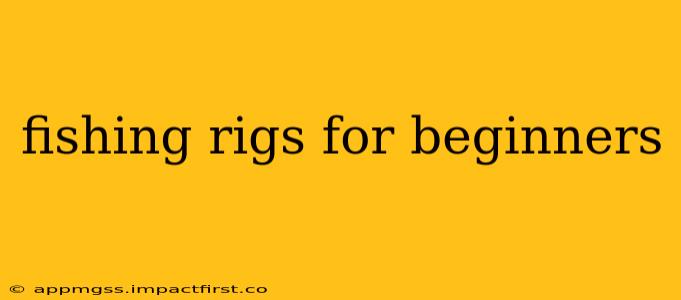Fishing can be a relaxing and rewarding hobby, but it can seem daunting for beginners. One of the first hurdles is understanding fishing rigs. This comprehensive guide breaks down the essentials, helping you choose the right rig for your fishing style and target species. We'll cover the basics, explore popular choices, and answer frequently asked questions to get you hooked on success!
What is a Fishing Rig?
A fishing rig is essentially the setup you use to present your bait or lure to a fish. It consists of the line, hooks, sinkers, and any additional components needed to effectively catch fish. Understanding different rigs helps you adapt to varying fishing conditions and target specific species.
Common Fishing Rigs for Beginners
Here are some of the most beginner-friendly and effective fishing rigs:
1. The Simple Hook Rig
This is the most basic rig, perfect for starting out. It's incredibly straightforward:
- Line: Attach your fishing line directly to a hook.
- Bait: Add your bait (worm, minnow, etc.) to the hook.
- Optional: For deeper water or stronger currents, you can add a small weight (split shot) a few inches above the hook.
Best for: Simple fishing scenarios, targeting smaller fish, and learning basic casting techniques.
2. The Slip Bobber Rig
This rig is excellent for presenting bait at a specific depth, particularly useful for fishing in deeper water:
- Line: Thread your line through a bobber (a buoyant float).
- Stop: Use a small bead or stop knot above the bobber to prevent it from sliding down the line.
- Weight: Attach a weight below the bobber to keep the bait suspended at the desired depth.
- Hook: Attach your hook below the weight.
Best for: Targeting fish at specific depths, particularly effective for catching panfish (sunfish, crappie) and trout.
3. The Carolina Rig
A more advanced, but still relatively easy rig, the Carolina rig excels at covering ground and attracting fish:
- Line: Use a bullet weight on the end of your main line.
- Swivel: Attach a swivel above the weight to prevent line twist.
- Leader: Tie a fluorocarbon leader (about 18-24 inches) to the swivel.
- Hook: Attach your hook to the end of the leader.
Best for: Covering large areas, fishing in deeper water with structure (weeds, rocks), and attracting bass and other game fish.
4. Texas Rig
Another popular bass fishing rig, the Texas rig excels at fishing through heavy cover:
- Line: Attach a weight (usually a bullet weight or Texas weight) directly to your hook.
- Bait: A soft plastic bait (worm, creature bait) is threaded onto the hook.
- Offset Hook: It's crucial to use an offset hook to prevent the hook from snagging on vegetation.
Best for: Fishing in heavy cover like weeds, grass, and wood.
What are the best types of hooks for beginners?
There are many types of fishing hooks available, but for beginners, some of the most versatile and easiest to use include:
- Kahle Hooks: Excellent for live bait like worms or minnows, as the curved design helps secure the bait and prevents it from slipping off easily.
- Baitholder Hooks: Similar to Kahle hooks, these feature barbs or notches to hold bait firmly in place.
The size of hook you'll need will depend on the size and type of fish you're targeting. It's always advisable to start with a medium-sized hook and adjust as needed.
What type of fishing line should I use as a beginner?
Monofilament line is generally recommended for beginners due to its affordability, versatility, and ease of use. A line strength of 6-10 pounds is a great starting point for most freshwater fishing applications.
What size sinkers should I use?
The size of sinker you need depends on the fishing conditions, current strength, and depth. Start with smaller sinkers and increase the weight if needed to get your bait down to the desired depth.
What are some tips for successful fishing?
- Patience is Key: Fishing requires patience. Don't get discouraged if you don't catch anything right away.
- Learn Your Local Waters: Research the types of fish found in the waters you'll be fishing and the best techniques for catching them.
- Observe Other Anglers: Watching experienced anglers can teach you valuable tips and techniques.
- Practice Makes Perfect: The more you fish, the better you'll become at it.
By mastering these fundamental fishing rigs, you'll significantly increase your chances of success and enjoy the rewarding experience of fishing. Remember to always practice responsible fishing habits and respect the environment. Happy fishing!
